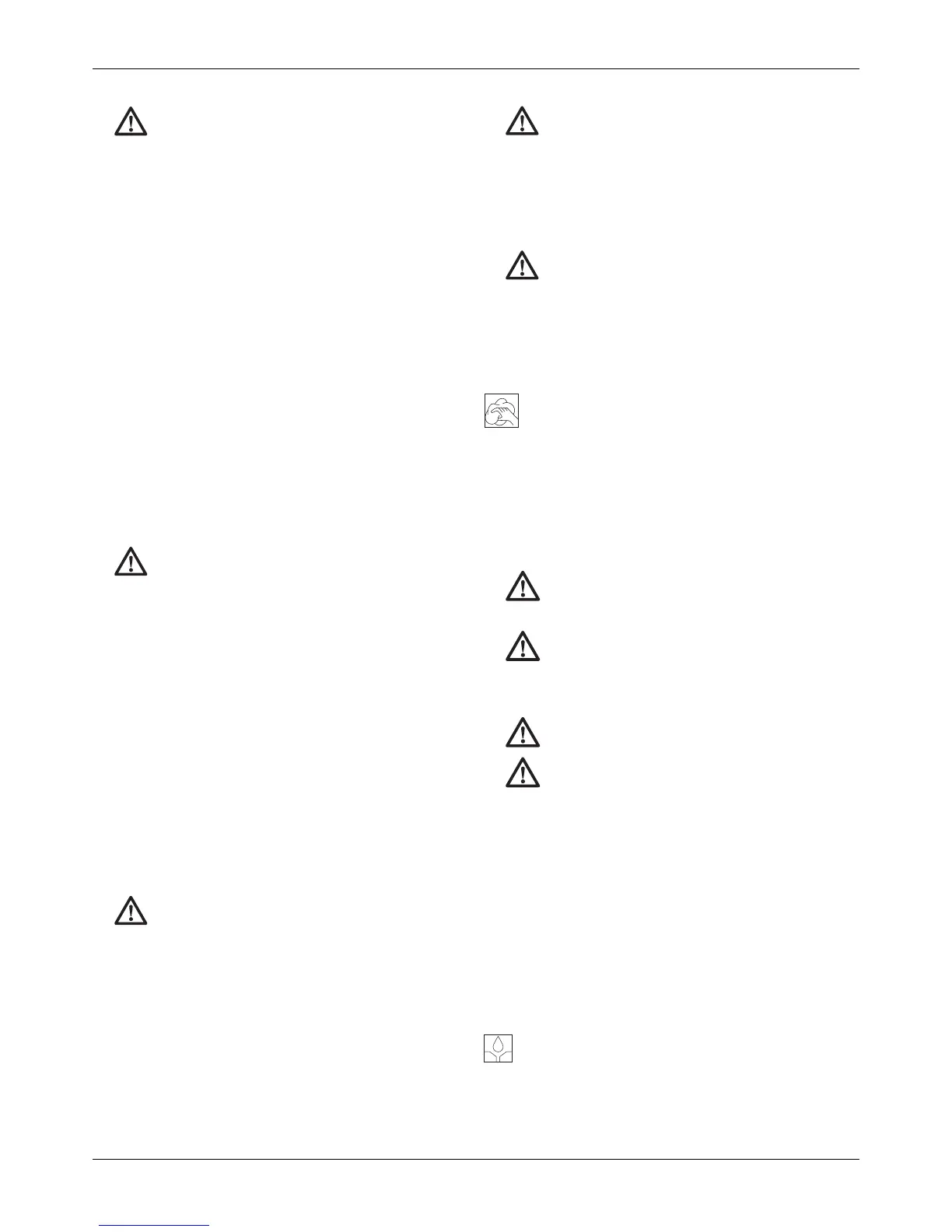15
ENGLISH
WARNING: When mitring the end of a piece of wood with a
small off-cut, position the wood to ensure that the off-cut is to
the side of the blade with the greater angle to the fence:
left mitre, off-cut to the right
right mitre, off-cut to the left.
Bevel cuts (fig. A1, K1 & S)
Bevel angles can be set from 48° left to 2° right and can be cut with the
mitre arm set between zero and a maximum of 45° mitre position right or
left.
• Loosen the left side fence clamping knob (58) and slide the upper part of
the left side fence (13) to the left as far as it will go.
Loosen the bevel clamp handle (15) and set the bevel as desired.
• Tighten the bevel clamp handle (15) firmly.
• Proceed as for a vertical straight cross-cut.
Compound mitre
This cut is a combination of a mitre and a bevel cut.
• Set the bevel angle and subsequently set the mitre angle.
Sawing in the bench mode
• Always use the riving knife.
• Always ensure that the riving knife and blade guard are correctly aligned.
• Always ensure that the mitre saw is set and locked in 0° mitre.
WARNING: Do not cut metal in this mode.
Ripping (fig. T)
• Set the bevel angle to 0°.
• Adjust the saw blade height. The correct blade position is to have the
tips of three teeth above the top surface of the wood. Ensure that the
saw bench table is securely fixed at the chosen height.
• Set the parallel fence to the required distance.
• Hold the workpiece flat on the table and against the fence. Keep the
workpiece approx. 25 mm away from the saw blade.
• Keep both hands away from the path of the saw blade.
• Switch the machine on and allow the saw blade to reach full speed.
• Slowly feed the workpiece underneath the upper blade guard, keeping it
firmly pressed against the fence. Allow the teeth to cut, and do not force
the workpiece through the saw blade. The saw blade speed should be
kept constant.
• Remember to use the push stick (73) when close to the blade.
• After completing the cut, switch the machine off, allow the saw blade to
stop and remove the workpiece.
WARNING:
• Never push or hold the free or cut-off side of the workpiece.
• Always use a push stick when ripping small workpieces.
Transporting (fig. B)
• To transport the saw, lower the head and depress the lock down pin
(17).
• Lock the table (19) into lowest position. Lock the rail lock knob with the
saw head in the front position, lock the mitre arm in the far right mitre
angle, slide the fence (13) completely inward and lock the bevel lever (15)
with the saw head in the vertical position to make the tool as compact
as possible.
• Always use the hand indentations (26) shown in fig. B to transport the
saw.
WARNING: Always transport the machine in saw bench mode
with the upper blade guard fitted. Never carry the machine by
the guard.
MAINTENANCE
Your DEWALT power tool has been designed to operate over a long
period of time with a minimum of maintenance. Continuous satisfactory
operation depends upon proper tool care and regular cleaning.
WARNING: To reduce the risk of injury, turn unit off and
disconnect machine from power source before installing
and removing accessories, before adjusting or changing
set-ups or when making repairs. Be sure the trigger switch
is in the OFF position. An accidental start-up can cause injury.
• If the saw blade does not stop in less than 10 seconds after switching
off, have the machine serviced by an authorised DEWALT repair agent.
Cleaning
Before use, carefully check the upper blade guard, movable lower blade
guard as well as the dust extraction tube to determine that it will operate
properly. Ensure that chips, dust or workpiece particle cannot lead to
blockage of one of the functions.
In case of workpiece fragments jammed between saw blade and guards
disconnect the machine from the power supply and follow the instructions
given in section Mounting the Saw Blade. Remove the jammed parts and
reassembling the saw blade.
WARNING: Blow dirt and dust out of the main housing with dry
air as often as dirt is seen collecting in and around the air vents.
Wear approved eye protection and approved dust mask when
performing this procedure.
WARNING: Never use solvents or other harsh chemicals for
cleaning the non-metallic parts of the tool. These chemicals
may weaken the materials used in these parts. Use a cloth
dampened only with water and mild soap. Never let any liquid
get inside the tool; never immerse any part of the tool into a
liquid.
WARNING: To reduce the risk of injury, regularly clean the
table top.
WARNING: To reduce the risk of injury, regularly clean the
dust collection system
Cleaning and maintaining the kerf plate (fig. U)
Regularly clean the area below the kerf plate.
If the kerf plate is worn it must be replaced.
• Remove the screws (74) holding the kerf plate (8).
• Remove the kerf plate and clean the area below.
• Re-install the parts of the kerf plate and the screws.
• Tighten the screws hand-tight.
• To adjust the kerf plate, proceed as follows:
• Pull down the head until the blade just enters the saw kerf.
• Adjust each part of the kerf plate to fit closely to the teeth of the blade.
• Tighten the screws.
L ubrication
This machine requires no additional lubrication. The bearings of the motor
are pre-lubricated and watertight.

